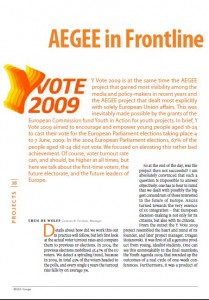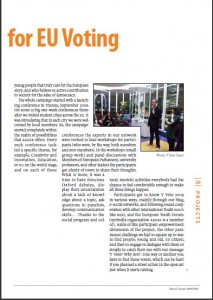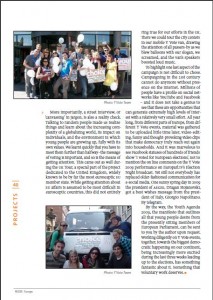Y Vote 2009
Y Vote 2009 is at the same time the AEGEE project that gained most visibility among the media and policy-makers in recent years and the AEGEE project that dealt most explicitly with solely European Union affairs. This was inevitably made possible by the grants of the European Commission Youth in Action fund for youth projects. In brief, Y Vote 2009 was aimed to encourage and empower young people aged 18-24 to cast their vote for the European Parliament elections taking place 4 to 7 June, 2009. In the 2004 European Parliament elections, 67% of the people aged 18-24 did not vote. We focused on elevating this rather bad achievement. Of course, voter turnout rate can, and should, be higher at all times, but here we talk about the first-time voters, the future electorate, and the future leaders of Europe.
Details about how did we work this out in practice will follow, but let’s first look at the actual voter turnout rates and compare them to previous EP elections. In 2004, the previous elections mobilized 45-47% of the EU voters. We detect a spiraling trend, because in 2009, in total 43% of the voters headed to the polls, and every single 5 years the turnout rate falls by on average 3%.
So at the end of the day, was the project then not successful? I am absolutely convinced that such a question is impossible to answer objectively. One has to bear in mind that we dealt with possibly the biggest conundrum of those interested in the future of Europe. AEGEE turned towards the very essence of EU integration – that European decision-making is not only for its citizens, but also with its citizens.
From the outset the Y Vote 2009 project resembled the heart and mind of its founder, and later Project Manager, Dragan Stojanovski. It was first of all a genuine product from young, idealist students. One can see this unmistakably in the final manifesto, the Youth Agenda 2009, that rounded up the outcomes of a real cycle of one-week conferences. Furthermore, it was a product of young people who truly care for the European story, and who believe in active contribution to society for the sake of democracy.
The whole campaign started with a launching conference in Vienna, September 2008. On some 15 big one-week conferences thereafter we visited student cities across the EU. It was stimulating that in each city we were welcomed by local members. So, the campaign moved completely within the realm of possibilities that AEGEE offers. Every such conference tackled a specific theme, for example, Creativity and Innovation, Education, or EU on the world stage, and on each of these conferences the experts in our network were invited to lead workshops for participants (who were, by the way, both members and non-members). In the workshops (small group work) and panel discussions with Members of European Parliament, university professors, and other leaders the participants got plenty of room to share their thoughts. What is more, it was a time to have ferocious Oxford debates, display their uncertainties about a lack of knowledge about a topic, ask questions to panelists, develop communication skills… Thanks to the social program and cultural, touristic activities everybody had the chance to feel comfortable enough to make all these things happen.
Participants got to know Y Vote 2009 in various ways, mainly through our blog, e-social networks, and following sound cooperation with other International Youth NGO’s like BEST, and the European Youth Forum (umbrella organisation AEGEE is a member of). Aside of this participant-empowerment dimension of the project, the other paramount challenge we had to square up to was to find people, young and old, EU citizen, and then to engage in dialogue with them or simply to catch their eye with our message ‘Y Vote? Why not?’. One way or another you have to find those voters, which can be hard if you planned a street action in the open air just when it starts raining.
More importantly, a street interview, or ‘canvassing’ in jargon, is also a reality check. Talking to random people made us realize things and learn about the increasing complexity of a globalizing world, its impact on individuals, and the environment in which young people are growing up, fully with its own values. We learnt quickly that you have to meet them further than halfway–the message of voting is important, and so is the means of getting attention. This came out as well during the UK Tour, a special part of the project dedicated to the United Kingdom, widely known to be by far the most eurosceptic EU member state. While getting attention about EU affairs is assumed to be most difficult in eurosceptic countries, this did not entirely ring true for our efforts in the UK. There we could tour the city centers in our mobile Y Vote van, drawing the attention of all passers-by as we blew balloons with our slogan, we screamed, and the van’s speakers boosted loud music.
To highlight one last aspect of the campaign is not difficult to choose. Campaigning in the 21st century cannot do anymore without presence on the internet. Millions of people have a profile on social networks like YouTube and Facebook – and it does not take a genius to see that these are opportunities that can generate extremely high levels of interest with a relatively very small effort. All year long, from different parts of Europe, from different Y Vote events, material was gathered to be uploaded little time later, video-editing, funny and thought-provoking video clips that make democracy truly reach out again into households. And it was marvelous to see Facebook statuses of hundreds of friends show ‘I voted for European elections’, not to mention the on-line comments on the Y Vote 2009 performance on Europarl.tv’s Election Night broadcast. Yet still not everybody has replaced older-fashioned communication for e-social media. One sunny spring day in 2009 the president of AEGEE, Dragan Stojanovski, got a best wishes message from the President of Italy, Giorgio Napolitano. By telegram.
By the way, the Youth Agenda 2009, the manifesto that outlines all that young people desire from the presently sitting members of European Parliament, can be sent to you by the author upon request. Working diligently on Y Vote events, together, towards the biggest democratic happening on our continent, being increasingly more excited during the last three weeks leading up to the elections, has something fantastic about it. Something that voluntary work deserves.
Written by Thijs de Wolff, AEGEE-Utrecht and Y Vote Content & Formats Manager
Originally published in Key To Europe 2009-2010





1 comment for “AEGEE in Frontline for EU Voting”